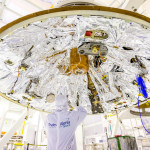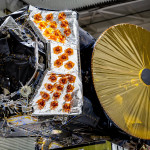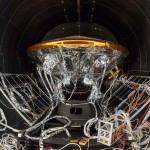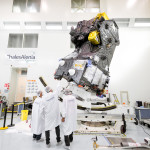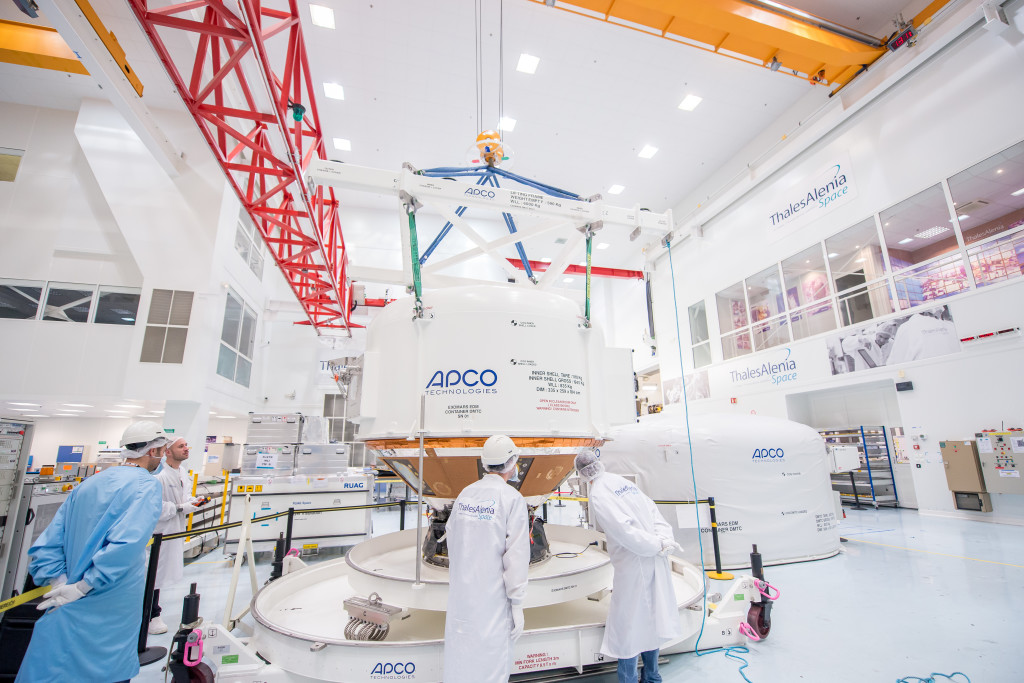
Thales – Iridium Mise en Container – 11 Décembre 2015 – Cannes
Mission Type: Mars Orbiter & Lander
Operator: ESA, RKA
Website: exploration.esa.int/mars
Mission Duration: 7 years (planned)
Manufacturer: Thales Alenia Space
Power: ~2000 W
Launch Date: March 14, 2016
Rocket: Proton-M/Briz-M
Launch Site: Baikonur 200/39
Spacecraft Component: EDM
Landing Date: October 19, 2016
The first mission of the ExoMars programme, scheduled to arrive at Mars in 2016, consists of a Trace Gas Orbiter plus an entry, descent and landing demonstrator module, known as Schiaparelli. The main objectives of this mission are to search for evidence of methane and other trace atmospheric gases that could be signatures of active biological or geological processes and to test key technologies in preparation for ESA’s contribution to subsequent missions to Mars.
The Orbiter and Schiaparelli will be launched together in March 2016 on a Proton rocket and will fly to Mars in a composite configuration. By taking advantage of the positioning of Earth and Mars the cruise phase can be limited to about 7 months, with the pair arriving at Mars in October. Three days before reaching the atmosphere of Mars, Schiaparelli will be ejected from the Orbiter towards the Red Planet. Schiaparelli will then coast towards its destination, enter the Martian atmosphere at 21 000 km/h, decelerate using aerobraking and a parachute, and then brake with the aid of a thruster system before landing on the surface of the planet.
From its coasting to Mars till its landing, Schiaparelli will communicate with the Orbiter. Once on the surface, the communications of Schiaparelli will be supported from Mars Exprees and from a NASA Relay Orbiter. The ExoMars Orbiter will be inserted into an elliptical orbit around Mars and then sweep through the atmosphere to finally settle into a circular, approximately 400-km altitude orbit ready to conduct its scientific mission.
- Working on the Schiaparelli flight model in a Thales Alenia Space cleanroom in Cannes, France.
- The Trace Gas Orbiter pictured in the Compact Antenna Test Range (CATR) at the Cannes (France) facility of Thales Alenia Space.
- The EDM being prepared for TV/TB test
- The Trace Gas Orbiter pictured in a cleanroom of Thales Alenia Space in Cannes, France.
The Orbiter spacecraft is designed by ESA, while Roscosmos provides the launch vehicle. A scientific payload with instruments from Russia and Europe will be accommodated on the Orbiter to achieve its scientific objectives. The Orbiter will perform detailed, remote observations of the Martian atmosphere, searching for evidence of gases of possible biological importance, such as methane and its degradation products. The instruments onboard the Orbiter will carry out a variety of measurements to investigate the location and nature of sources that produce these gases. The scientific mission is expected to begin in December 2017 and will run for five years. The Trace Gas Orbiter will also be used to relay data for the 2018 rover mission of the ExoMars programme and until the end of 2022.
Schiaparelli, the ExoMars entry, descent and landing demonstrator module will provide Europe with the technology for landing on the surface of Mars with a controlled landing orientation and touchdown velocity. The design of Schiaparelli maximises the use of technologies already in development within the ExoMars programme.
These technologies include: special material for thermal protection, a parachute system, a radar Doppler altimeter system, and a final braking system controlled by liquid propulsion.
Schiaparelli is expected to survive on the surface of Mars for a short time by using the excess energy capacity of its batteries. The science possibilities of Schiaparelli are limited by the absence of long term power and the fixed amount of space and resources that can be accommodated within the module; however, a set of scientific sensors will be included to perform limited, but useful, surface science.
After launch and throughout the cruise phase, the spacecraft unit made up of the Trace Gas Orbiter and Schiaparelli is operated by ESA through the space communications network of ESA’s European Space Operations Centre (ESOC). After separation, the Orbiter will monitor the UHF transmission from Schiaparelli from its coasting to Mars till its landing. ESA’s Mars Express and a NASA Relay Orbiter will act as a data relay for Schiaparelli during its surface operations. Furthermore, ground-based communication arrays will also track the UHF signal during the entry, descent and landing phases. ESA will be in full control of the Orbiter during all phases of its mission, including insertion into Mars orbit, orbit control, aerobraking, science operations and Mars communications operations.
